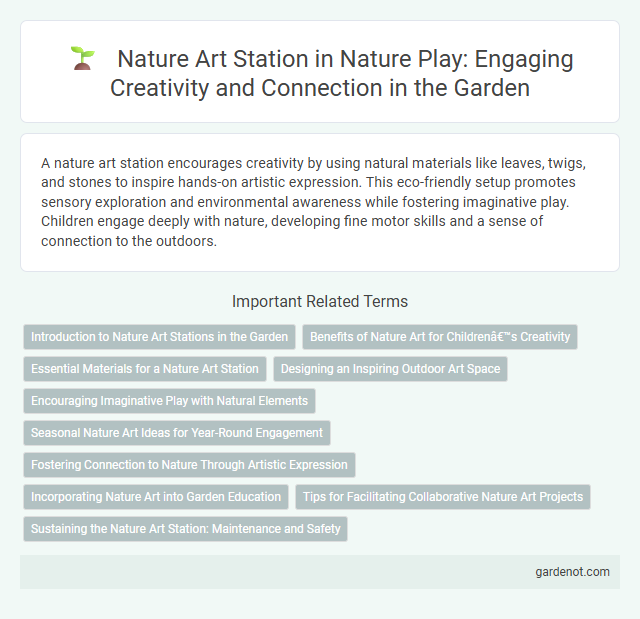A nature art station encourages creativity by using natural materials like leaves, twigs, and stones to inspire hands-on artistic expression. This eco-friendly setup promotes sensory exploration and environmental awareness while fostering imaginative play. Children engage deeply with nature, developing fine motor skills and a sense of connection to the outdoors.
Introduction to Nature Art Stations in the Garden
Nature art stations in the garden provide hands-on creative experiences using natural materials like leaves, twigs, stones, and flowers. These stations encourage sensory exploration and environmental awareness by allowing participants to craft, assemble, and display art inspired by the surrounding ecosystem. By integrating elements of ecology and creativity, nature art stations foster a deeper connection to the outdoors and enhance mindfulness through artistic expression.
Benefits of Nature Art for Children’s Creativity
Nature art stations foster children's creativity by encouraging hands-on interaction with natural materials like leaves, twigs, and stones, enhancing sensory experiences and imaginative thinking. Engaging in nature-based art activities improves fine motor skills, problem-solving abilities, and emotional expression through a tactile and visually stimulating environment. Exposure to organic textures and natural patterns inspires innovative ideas and deepens children's connection to the environment, promoting holistic cognitive development.
Essential Materials for a Nature Art Station
Essential materials for a nature art station include natural items such as leaves, pinecones, sticks, stones, and flowers, which serve as versatile tools for creative expression. Recyclable and eco-friendly supplies like biodegradable glue, natural dyes, and recycled paper support sustainable crafting practices. Collecting these elements encourages hands-on exploration and fosters a deep connection with the environment while promoting sensory development and artistic skills in children.
Designing an Inspiring Outdoor Art Space
Designing an inspiring outdoor art space within a nature play environment involves integrating natural materials such as stones, leaves, and twigs to spark creativity and sensory exploration. Utilizing open, flexible layouts encourages spontaneous artistic expression and collaborative projects among children. Incorporating sustainable elements like recycled wood and native plants enhances ecological awareness while enriching the aesthetic experience.
Encouraging Imaginative Play with Natural Elements
Nature art stations foster imaginative play by providing children with natural materials such as leaves, twigs, stones, and flowers to create unique artworks. These stations enhance creativity and sensory exploration while promoting environmental awareness. Engaging with natural elements in art encourages problem-solving and fine motor skills development in a hands-on, open-ended play environment.
Seasonal Nature Art Ideas for Year-Round Engagement
Seasonal nature art ideas transform outdoor spaces into dynamic creative studios, using materials like autumn leaves, spring blossoms, winter pinecones, and summer wildflowers. Incorporating these natural elements encourages sensory exploration and fosters environmental awareness throughout the year. Rotating themed art stations aligned with seasonal changes enhances continuous engagement and inspires connection with nature's evolving beauty.
Fostering Connection to Nature Through Artistic Expression
Nature art stations provide immersive opportunities for participants to engage creatively with natural materials, fostering a deeper emotional and sensory connection to the environment. Utilizing elements such as leaves, stones, and twigs encourages exploration and mindfulness, enhancing ecological awareness and appreciation. This hands-on artistic expression strengthens individuals' bonds to nature by translating natural experiences into personal, tangible creations.
Incorporating Nature Art into Garden Education
Nature art stations transform garden education by encouraging hands-on creativity with natural materials such as leaves, twigs, and stones, fostering environmental awareness and sensory exploration. Integrating these art activities enhances observational skills and deepens students' connection to their surroundings, promoting sustainability and ecological understanding. Educators utilize nature art to inspire imagination while reinforcing lessons in biology, ecology, and conservation within an interactive outdoor setting.
Tips for Facilitating Collaborative Nature Art Projects
Encourage open communication by providing clear materials and prompts that inspire creativity and teamwork in nature art stations. Incorporate natural elements like leaves, twigs, and stones to foster hands-on collaboration and environmental engagement. Set achievable goals and celebrate group efforts to enhance motivation and collective problem-solving skills.
Sustaining the Nature Art Station: Maintenance and Safety
Regular maintenance ensures the Nature Art Station remains safe and functional, with routine inspections of materials, tools, and structures to prevent hazards. Using eco-friendly, durable resources minimizes environmental impact and prolongs the lifespan of artistic installations. Safety protocols, such as clear signage and supervised usage, protect both participants and the surrounding natural habitat.
Nature art station Infographic

 gardenot.com
gardenot.com